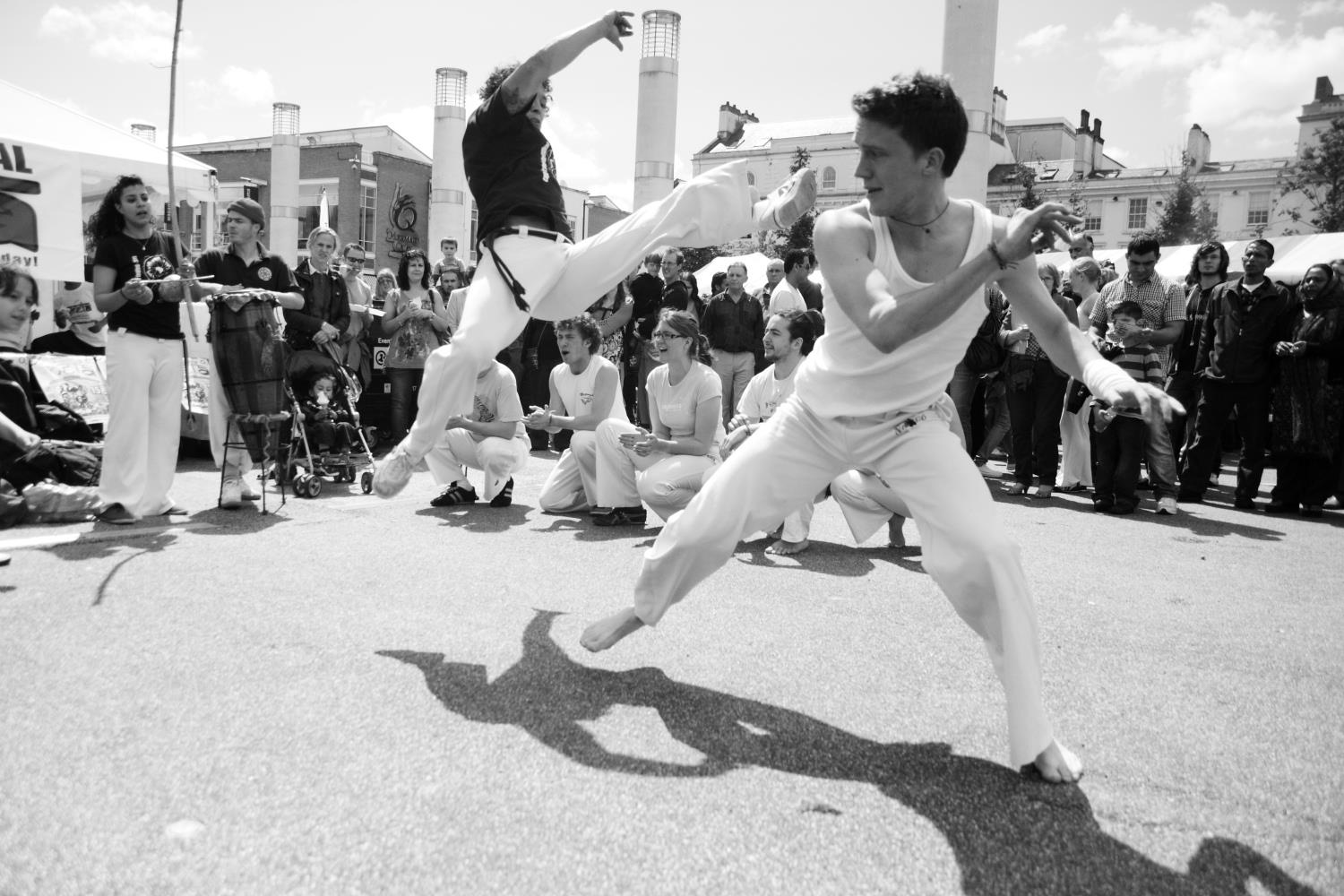The role of Societies Editor provides you with the opportunity to do things you would, perhaps, not usually think of doing. That, at least, is what IÔÇÖve found, and this idea was in my mind when I got an email from the Capoeira Society (I must here confess to having misspelled that once in a past edition of the paper, to my embarrassment). You may have seen their impressive performance at Global Village last year like I did, or have seen evidence of their Winter Festival around Cardiff in November. So I was excited when they invited me to come along to one of their sessions, held at the NoFitState dance studio in town on Wednesday evenings and at Talybont Sports Centre on Fridays.
And so it was on a Friday evening that I went up to Taly and joined the group for what was a really memorable experience. Capoeira is like no other ÔÇÿsportÔÇÖ you will come across, and part of its uniqueness, I soon found, was the idea that it is not so much a ÔÇÿsportÔÇÖ but a skilled game of ÔÇÿplayÔÇÖ in which you essentially aim to use the space around you to the greatest advantage with strength and control, whilst remaining aware of your partner, anticipating their moves and showing off your own in a game of wits. You can grasp an idea of this from the photos. There seemed to be little bodily contact during training, so in that sense it felt very different to training in the most common martial arts. It sounds unusual and it has, after all, evolved in an unusual and fascinating way from an unlikely historical source ÔÇô the African slave trade of the Brazilian colonies. Descendants of these slaves developed a martial art form combining music and dance with native Brazilian influence. It still uses the Portuguese language today, and I managed to get my tongue round a few of the key ones, like ÔÇÿmandingaÔÇÖ, translatable as ÔÇÿmagicÔÇÖ or ÔÇÿspellÔÇÖ and used to refer to the strategy of tricking your opponent, and ÔÇÿmalandragemÔÇÖ, the ability to quickly understand your opponentÔÇÖs intentions so you can trick him. Picking up a bit of the language is a great bonus of going regularly, as part of a rhythm is created by a call and response pattern between the tutor or mestre and the group. Those who take it up can also work, as in other martial arts, towards gaining belts symbolising different levels and beginning with blue. ItÔÇÖs probably also worth mentioning that the group often makes trips to Brazil during the year. Just another tiny bonus.
The Cardiff group mestre Claudio Campos explained the capoeirista as someone who has ÔÇÿelements of the acrobat, the dancer, the fighter and the musicianÔÇÖ – the best being adaptable to what is going on at the time. It really offers a clean page to those who try it out, as nearly everyone has interests in one of these skills, and no previous experience of any of them is required to start learning. And for any gents out there with their modern-man scepticism of dancing itÔÇÖs worth mentioning that historically, after the slave trade ended, male capoeiristas were blokes that you didnÔÇÖt mess with – they were the bouncers, body-guards and hitmen of their age, and were deemed so dangerous that Capoeira was prohibited. In recent years, it has become the national dance of Brazil, symbolising the struggle of the slaves to maintain some freedom in cultural identity under their oppressors. It is something reflected in the way they play: the group form a ring or roda around two opponents, (one of these normally the mestre), clapping in time with the music. Most took turns being in the centre and also took turns on the traditional instruments (which you could also pick up how to play). These beat out a rhythm that gets faster and faster, until you are almost lost in the beat. When you are a part of it, itÔÇÖs easy to see how Capoeira could have been used to stir up a rebellion and why slave owners feared it. The gameÔÇÖs inclusive character almost comes to have a life of its own as everyone becomes part of the quick musical rhythm, and you canÔÇÖt help but be mesmerised by it.
Capoeira is an amazing art form to have come out of one of the greatest oppressions in human history, remarkably having been prohibited in Brazil until 1937 ÔÇô but that perhaps explains its particularly freeing character. This difficult history is never far from the art today ÔÇô I found that the sticks rhythmically hit together in a dance style called Maculel├¬ are an alternative to machetes, used by slaves in the plantation. Each group member also traditionally will have a ÔÇÿnicknameÔÇÖ or apelido, something used for protection during the prohibition of Capoeira, so no member could give away his fellows to the brutal Brazilian police: I came across ÔÇÿPopeyeÔÇÖ, ÔÇÿAntÔÇÖ and ÔÇÿLittle CarrotÔÇÖ whilst I was there, and a rather tall chap who was aptly named ÔÇÿLegs of a CricketÔÇÖ! ItÔÇÖs done with a good sense of humour and, as long-standing member Sian put it, ÔÇÿthere are plenty of reasons to smile ÔÇô after all, you can only laugh about something like being head-butted on the bum!ÔÇÖ (and giving the offending partner a nudge off balance, perhaps).
It was good to see a few new people trying it out and enjoying it. One shared with me afterwards: ÔÇÿItÔÇÖs relaxing but with energy – I really enjoyed it!ÔÇÖ ÔÇô and having experienced Capoeira with this great group, I certainly agree. In the hope that others will go along and try it on the strength of what I can say, I am proud to introduce the fantastic society of Capoeira in more detail as they enter the second semester of their 2nd year as a society of Cardiff, and urge you to give it a go – another New YearÔÇÖs resolution, perhaps? You wonÔÇÖt be disappointed.
For training session times and dates, please visit http://groups.cardiffstudents.com/capoeira/about/
President: Esther Warnert – WarnertEA@cardiff.ac.uk
If you would like me to come along and get excited about your Society, then just email societies@gairrhydd.com!





Add Comment